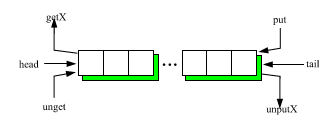
|
|
This
group of functions treats a String as a queue.
The primary operators are
put and
getX, which correspond to << and >> on iostreams
and unputX and
unget, which make it possible to use a String as
a stack or deque
Figure 1 shows the relationships
of the queue-oriented functions.
They allow new characters to be added or removed
at either end of the String. put and
unget, the operators that add characters to the
String, can also take String arguments,
so they serve as append and prepend operators
(respectively) as well.

Queue-oriented functions
String& String::put(char);
s.put(c) puts character c
on the end of String s, s.put(t)
appends String
t to String s and
s.put(p) appends the characters pointed to by character
pointer
p to s.
put returns its updated object, so
s.put('y').put('z') will append
"yz" to String
s. The meaning of s.put(t)
is the same as
s += t.
int String::getX(char&);
If String s is non-empty,
s.getX(c) gets (and removes) the first character
from
s, assigns it to c,
and returns 1. Otherwise, s and
c are unchanged, and the return value is 0.
String& String::unget(char);
s.unget(c) undoes the effect of
s.getX(c) (which removes the first character from
s); that is, it puts c
back on the front (got that?) of s. In another
sense, unget is the reverse of
put since it prepends rather than appends to its
object. The type rules are exactly the same as for put.
unget returns its object.
int String::unputX(char&);
s.unputX(c) undoes the effect of
s.put(c) (which appends c
to
s); that is, it gets (and removes) the last character
from String
s, and assigns it to c.
Similarly, in another sense, unputX is the reverse
of getX since it removes the last (instead of the
first) character of its String.
Both getX() and unputX()
have variants that do not take an argument but otherwise have the same effect:
to remove an element from the queue and return 1,
if the queue was non- empty, and
to return 0 otherwise.
Since they don't assign to their argument, they don't have
the final ``X'' and are called
get() and
unput().
The remove function at the beginning of the
paper is an example of the use of
getX.
A stack can be easily constructed using
put and unputX:
class char_stack : private String {
public:
char_stack() {}
~char_stack() {}
empty() { return is_empty(); }
char pop() { char x; if (!unputX(x))
error();
return x; }
void push(char x) { put(x); }
}
Notice that unget and getX
could have been used instead of put and
unputX.